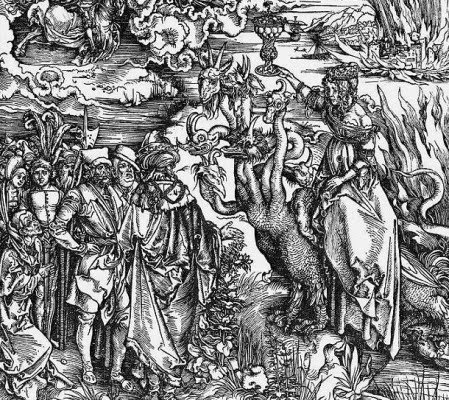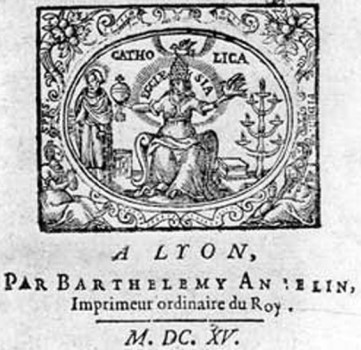Loredan: yes, thanks for the mitre. But wasn't Sister Manfreda probably an abbess before she took the title of popess? Her order wasn't big enough to have cardinals. So I don't see a problem, at least as regards the PMB card. The abbess staff reinforces her interpretation as Manfreda.
The Cary Sheet card is a special case, one of a kind. If it weren't for the book, her ambiguously feminine appearance, her churchiness, and especially that she is one a group of tarot cards near the time of the Steele Sermon, I'd wonder myself if she was a popess. I think it's a case of an artist's timidity and orthodoxy. He also can't bring himself to give her a clear-cut papal tiara, or even make her unambiguously female.
It's like the "anonymous discourse" that Marcos quoted: that poor guy is looking at a bunch of cards with two popes in it. He can't bring himself to accept that it's two popes, even male ones, because there can only be one pope;so one of them, he decides, has to be a cardinal! Here is the quote again, with the machine's translation:
«Seguono due Papi, uno col Regno et l’altro senza et doppo questi L’Imperatore, et il Re, che sono le due supreme dignità; nello spirituale Cardinale et Papa, nel temporale Re et Imperatore».
("Two Popes follow, one with the Kingdom et the other without et doppo these The emperor, et the King, they are the two supreme dignities; in the spiritual Cardinal et Pope, in the temporal King et Emperor.")
Similarly, one reason that the Eastern Church and the Western Church couldn't get together was the same issue: the West insisted upon just one Pope over all, so the Eastern patriarchs had to be cardinals, not popes over their own regions. That's a reason why I thought, and still speculate, that Bessarion had something to do with the "two popes" decks: as an Easterner and a Westerner, he wouldn't have thought there was anything wrong with two popes. "Two popes" is from this perspective propaganda for ecumenicism.
Huck: a nun in white headgear and black robe, with no tiara, is not the same as the PMB Popess with tiara in brown robe, which was apparently the order's color. The black-white is a typical nun's outfit, identifying her merely with the Church. Most of the Popess cards have the tiara and something else, a book or a key, to make her the female counterpart of the Pope. But I grant you that there is a ready association, for those who wish it, of any female cleric on a card to the Church, by way of the sponsa of the Song of Songs, fallen, in your pageant, among bad company; or simply because
Ecclesia is a feminine noun.
Marcos quoted Decembrio:
Gli piaceva anche giocare con gli astragali: genere di giuoco che, per il suo richiamo omerico, ha trovato celebratori recenti. Nei giorni festivi talvolta giocava a dadi mentre, più che giocare, preferiva assistere alle partite con quelli che la gente chiama scacchi.
A machine translation:
He also liked to play with the astragalis: kind of game that, for his/her Homeric call, you/he/she has found recent celebrators. In the festive days it sometimes played to dice while, more than to play, preferred to assist to the games with those that people call chess.
This shows pretty clearly that although he knew the rules and could appreciate a good game he wasn't a player. He "assisted," meaning he watched others and maybe made suggestions. That's more than Tolfo would concede, so I thank you for the correction. The chess analogy is not ruled out on the grounds that Filippo didn't know chess. But I still wonder wheher he would have wanted a card game based on chess, because it would remind him of a game he didn't play well, and he wouldn't enjoy it as much.
c) The popess Giovanna. I think this possibility is maybe--, especially after the Counter Reformation.
The popess Giovanna was used as a tool of the Protestants (the whore of Babylon). But just in Protestant countries the card was withdrawn (Junon, Fracasse ...). If she is Giovanna, the natural thing was to keep it.
I think there is a difference between Popess Joan and the whore of Babylon. Popess Joan was admirable, up to a point, and not an indictment of the whole Catholic Church. Even her deceptiveness is because of the Church's misogyny. The "whore of Babylon" image is much stronger than Pope Joan, it's Pope Joan to the nth power, the whole hierarchy. And anyway, the "whore of Babylon" association is of a later time. It might have been an association in Protestant countries, sort of a "see, even the Italians considered the Church a whore." Belgium was officially Catholic, not Protestant, although many spoke the same language as nearby Netherlands, hence much mixing back and forth. And Switzerland was a confederacy that had both Catholic and Protestant constituents (
http://en.wikipedia.org/wiki/Religion_in_Switzerland). It occurs to me that perhaps the change to Fracasse and Juno was because they feared a Popess would cause brawls, owing to the "whore of Babylon" association.
I don't think France would have retained this card if it been Popess Giovanna.
They probably had various theories of what the card meant. By then "Popess" was just a placeholder, having only the primary meaning of "female counterpart of the Pope," onto which to project whatever fit their conceptions: the Church, Pope Joan, and later (by late 1600s) Isis, Mary, or something else. France, too, was both Catholic and Protestant, with much fighting between the two sides, subsiding a little under the Edict of Nantes; and then, somewhat after the time of the Noblet, Louis XIV got rid of the Protestants, So to avoid conflict, although not changing the title or image, there would have been a need for other associations besides Popess Joan.
Isis.
- The card is found in human court, not between the stars-gods.
- And why not Diana or Athenea or Dafne or another goddess that appears in a document of the time. Iconographic or conceptually not make any sense that symbolizes Isis
In Boccaccio Isis is presented as a woman; the book is
Famous Women. The early humanists treated pagan gods as historical persons deified by the people because of their unusual abilities. Even Marziano does so, as the Introduction to Trionfi's translation (
http://trionfi.com/0/b/07/index.php) states:
The title " Tractatus De Deificatione Sexdecim Heroum " and the later text (" celestial princes and barons ") gives the impression, that the Greek gods are considered as deified heroes..,
But even in the ancient sources Isis was treated as human (and goddess only before and after she's on earth): her brother Osiris is killed twice, she fears for her son's life growing up, from scorpion bites, etc.
I don't have reason to think that the Popess was associated with Isis at the beginning, but slowly over time: for a few people, in the Cary Sheet, more by the 17th century in France, when Egyptomania was in full bloom there. What associates her with Isis is her prominent book, stole, and curtain; and that she had a male counterpart. Athena doesn't have these characteristics. Diana has only the male counterpart (Apollo); even so, some perhaps associated her with the Popess, as associated with the Moon (which is also an association to the Dyad in the
Theology of Arithmetic), also associated with the sponsa of the Song of Songs ("dark but comely" vs. "ruddy"). But that is a much weaker association.
Marcos writes,
En general, creo que las primeras barajas del tarot tienen más que ver con la Genealogía de los dioses de Boccaccio que con Las imágenes de los dioses de Cartari. En el período que media entre Boccaccio y Cartari podemos apreciar la progresiva neoplatonización y orientalización de la mitología, pero hasta entonces hay que se muy cautelosos. La baraja de Michelino está inspirada en Boccaccio y Boccaccio no confunde a Isis con la Virgen, ni a cualquier otro dios de la mitología grecolatina con las figuras del cristianismo.
Or, through the translation machine:
In general, I believe that the first cards of the tarot have more that to see with the Genealogy of the gods of Boccaccio that with The images of the gods of Cartari. In the period that happens between(among) Boccaccio and Cartari we can estimate the progressive neoplatonización and orientalización of the mythology, but till then there is that very cautious. Michelino's card is inspired in Boccaccio and Boccaccio does not confuse Isis with the Virgin, not to any other god of the Greco-Roman mythology with the figures of the christianity.
I agree that Boccaccio does not reflect the "progressive neoplatonization and orientalization" of the mythology that we find in Cartari. I was careful to cite Cartari only in reference to the Noblet card and after. I cited Boccaccio (
Famous Women, not the
Geneology) for the Steele Sermon, Aretino, Schoen, and in part for the PMB (and including other Popess cards of that time, as reflected in the Rosenwald).
In between the two mythologists, especially between 1440 and 1550, is the transition. In 1440 the Italian merchant and antiquarian Cyriacus is already back from Egypt, reporting to Eugenius IV about his trip (Curran,
The Egyptian Renaissance: The Afterlife of Ancient Egypt in Early Modern Italy, p. 60). In 1445 Leonello goes to see sister Beatrice in an "Isis show," as Huck reports. 1449 finds Cyriacus in Ferrara viewing the Belfiore Muses, but probably not invited there by Leonello just for that reason. In 1454 or 1455 Beatrice marries Tristano Sforza and moves to Milan, dying there c. 1497, the probable era of the Cary Sheet. In 1486 comes Pico's revival of ancient syncretism (see Farmer,
Syncretism in the West: Pico's 900 Theses). The times are already changing.


